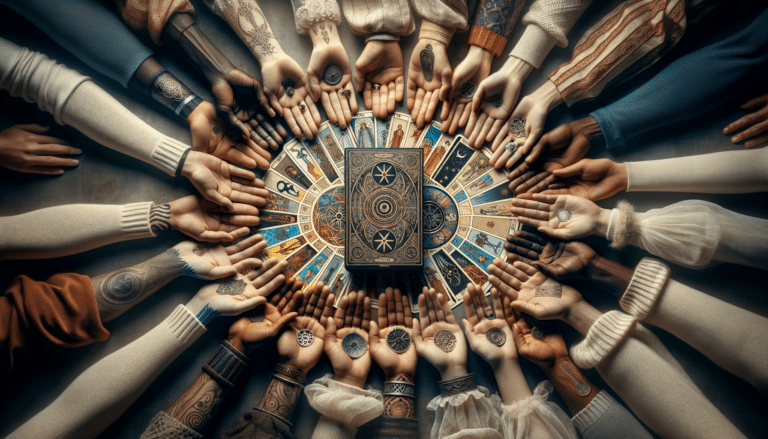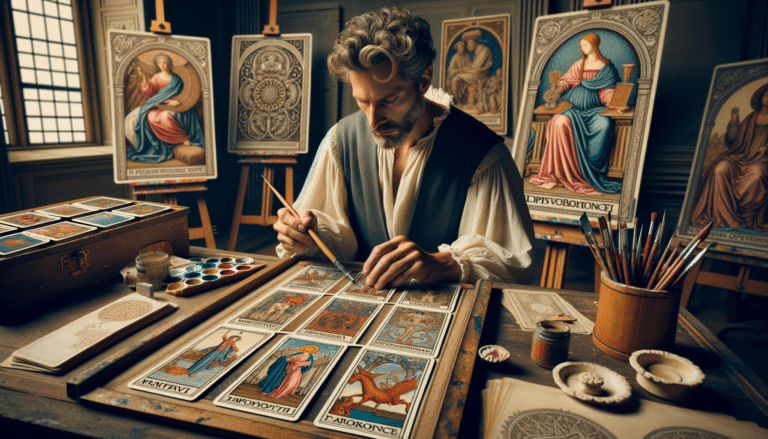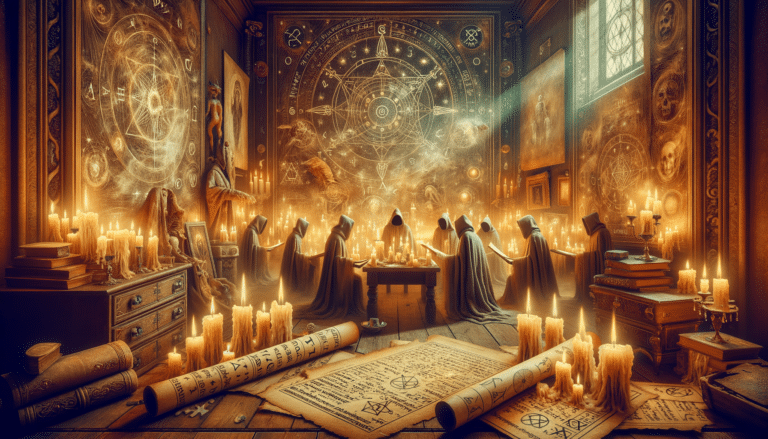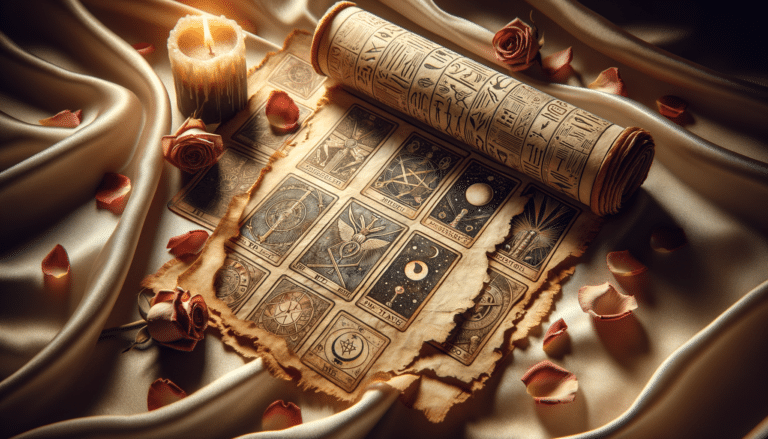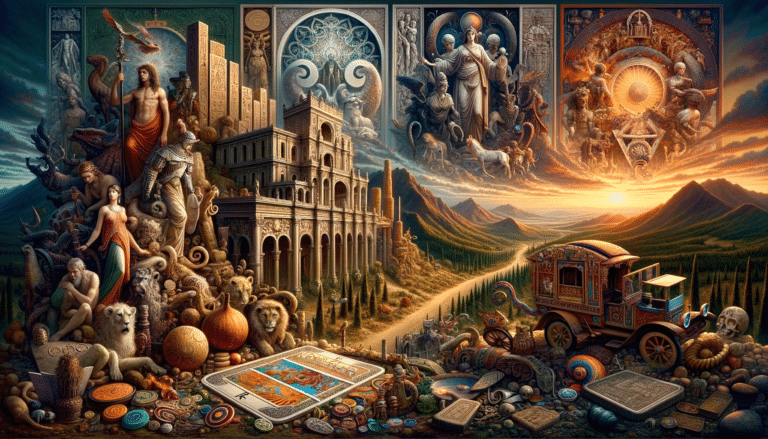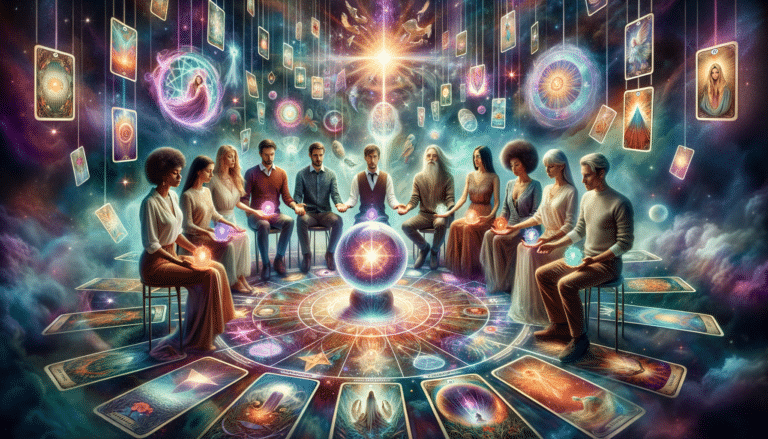Tarot Interpretation in Historical Context: Essential Insights
You might not realize that tarot cards were initially just for play in the mid-15th century, far from the mystical oracle you’re familiar with today. As you delve into their storied past, you’ll discover the tarot’s evolution over the centuries, reflecting the shifting tides of history, culture, and belief systems.
From their emergence during the Renaissance, infused with symbolic imagery, to their intertwining with medieval mysticism and the occult, the tarot has been a mirror to the human psyche. Understanding how the Age of Enlightenment and modern cultural shifts have shaped their interpretation offers you a richer perspective on the cards’ meanings.
So, let’s embark on a journey to unravel how tarot interpretation in historical contexts have lent layers of depth to the tarot, transforming it into the tool for personal insight you seek today.
Key Takeaways
- Tarot cards originated in Europe as playing cards in the 15th century and evolved into tools for divination.
- The symbolism and interpretations of tarot cards have transformed over time, reflecting shifts in beliefs, values, and societal norms.
- Tarot’s interpretations are influenced by cultural and historical factors, such as political power, religious influence, and artistic expressions.
- Tarot is connected to mysticism and the occult, serving as a bridge between individuals and esoteric traditions.
Origins of Tarot Cards
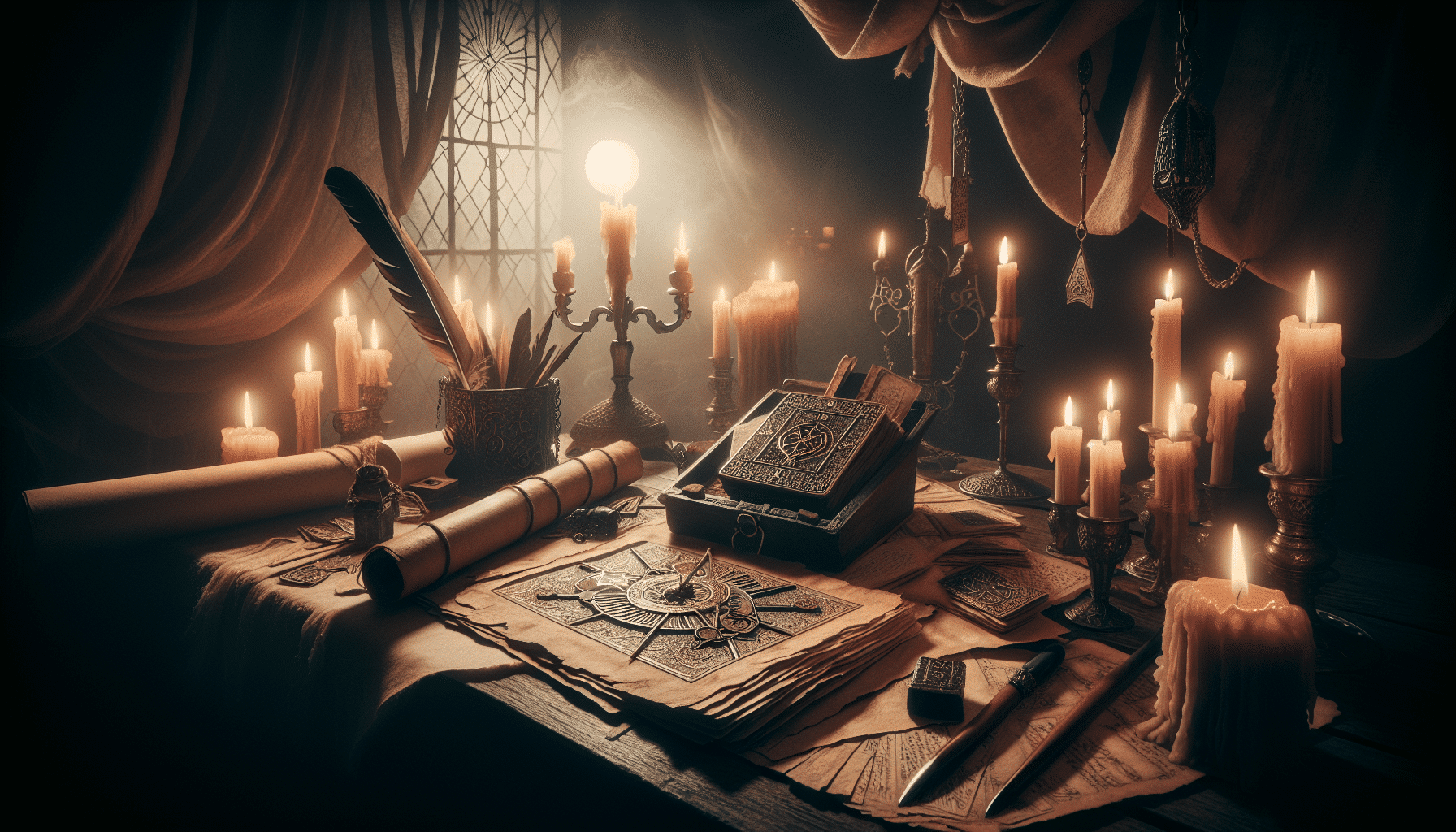
Before delving into the mystical realm of tarot interpretations, you’ll discover that the origins of tarot cards date back to the 15th century in Europe, where they began as a form of playing cards. These early decks were hand-painted, showcasing the artistry and craftsmanship of the period. As you explore further, you’ll find that the practice of card printing hadn’t yet evolved to the mass production methods we’re familiar with today.
The designs of the original tarot cards were likely influenced by Mamluk cards, which came from the Islamic society in Egypt. These Mamluk cards didn’t depict humans due to religious constraints, but featured intricate patterns and iconography that fascinated European card makers. When you consider this blend of cultural influences, you’ll see how tarot’s rich visual language was born.
As card printing technology advanced, tarot cards became more accessible, leading to their spread across Europe. Initially, these cards weren’t associated with mysticism but were used for games and entertainment. It wasn’t until centuries later that tarot took on a more esoteric significance. You’re now on the brink of understanding how tarot evolved from simple playing cards to a nuanced tool for divination.
Tarot’s Evolution Over Centuries
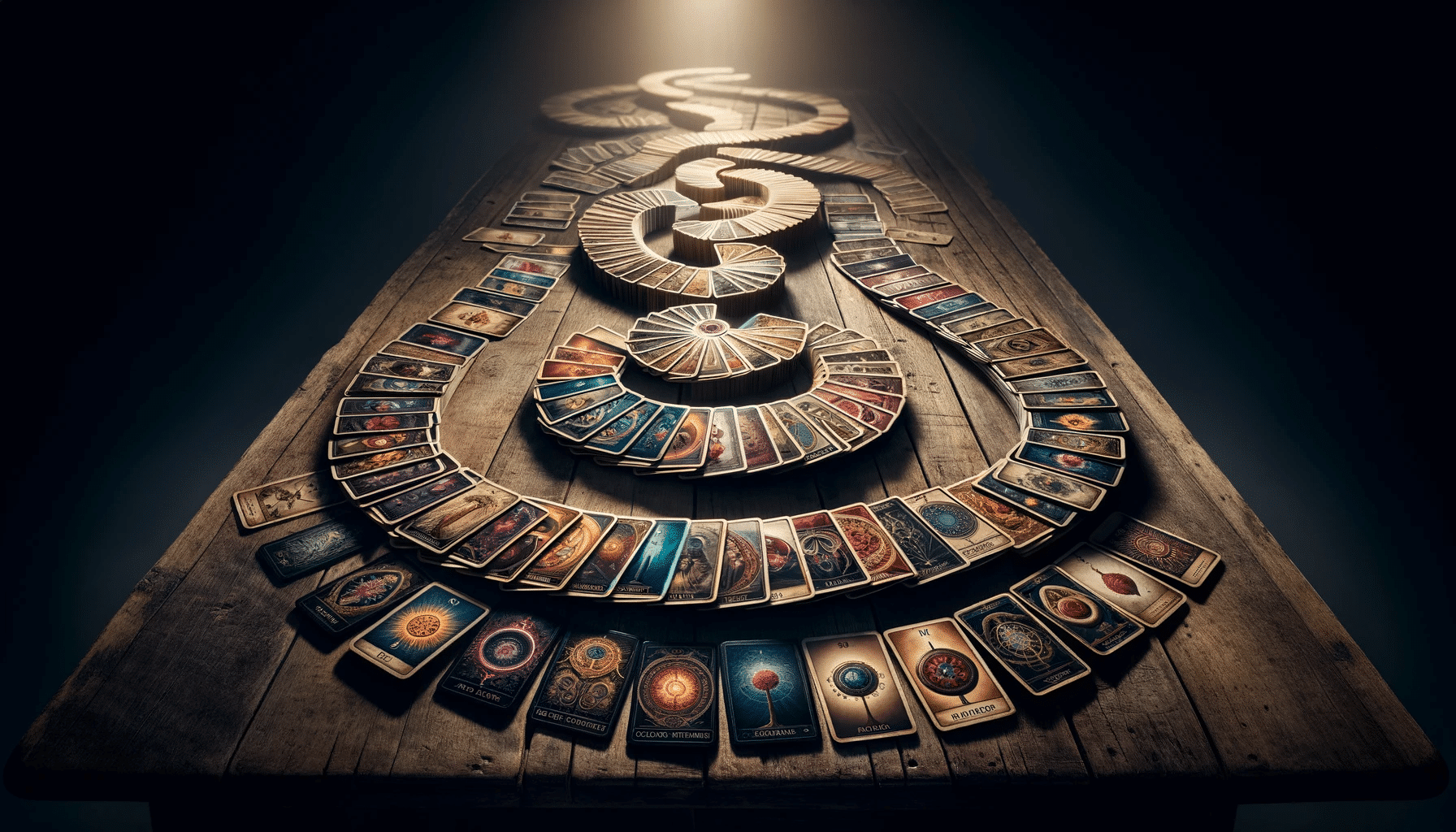
As you explore tarot’s journey through time, you’ll uncover how its origins and adaptations have shaped its current form.
You’ll notice that symbolism has shifted, reflecting the ever-changing tapestry of human belief and experience.
Origins and Adaptations
You’ll find that the tarot deck, with its rich symbology and diverse applications, originated in the 15th century as a card game in Europe before evolving into a tool for divination.
Initially, these decks were used for playing various card games, with the Italian suits of swords, cups, coins, and batons serving as predecessors to the modern clubs, hearts, diamonds, and spades.
As the popularity of tarot spread, so did its purposes. Over time, mystics and occultists adapted the imagery and symbolism of the cards, attributing deeper meanings to the archetypes and figures depicted.
This transition marked a pivotal change from playful pastime to a reflective tool for insight, aligning tarot’s evolution with cultural and spiritual practices.
Symbolism Shifts
In your journey through tarot’s history, the symbolism evolution reflects society’s shifting beliefs and values over centuries. Each card’s arcane etymology reveals layers of meaning that have transformed along with divinatory practices. As you delve deeper, you’ll see how the Fool’s leap of faith has journeyed from simple folly to complex trust in the unknown, mirroring our own evolving relationship with risk and adventure.
Understanding this symbolic metamorphosis is crucial. It’s not just about how the images have changed; it’s about why. Shifts in political power, religious influence, and cultural movements have all left their mark on the tarot, reshaping interpretations and uses.
This evolution is a testament to the tarot’s resilience and its ability to adapt to the ever-changing human experience.
Cultural Influence Dynamics
Through centuries of cultural tides, you’ve witnessed tarot’s interpretations evolve, reflecting the prevailing ideologies and societal norms of each era. As you delve into tarot’s storied past, you grasp how sociopolitical impacts have consistently shaped the deck’s use and meaning.
In times of upheaval, tarot readings often mirrored collective anxieties, while periods of cultural renaissance saw the cards infused with more nuanced, philosophical insights.
Artistic expressions within the tarot also shifted dramatically, with each artist pouring their zeitgeist into the imagery. The cards became a canvas for the prevailing aesthetic and moral landscape, transforming tarot’s visual and interpretative language.
Understanding this cultural dance offers you a richer appreciation of tarot’s multifaceted evolution over the centuries.
Check out our Tarot Cards here…
Renaissance Influence on Tarot
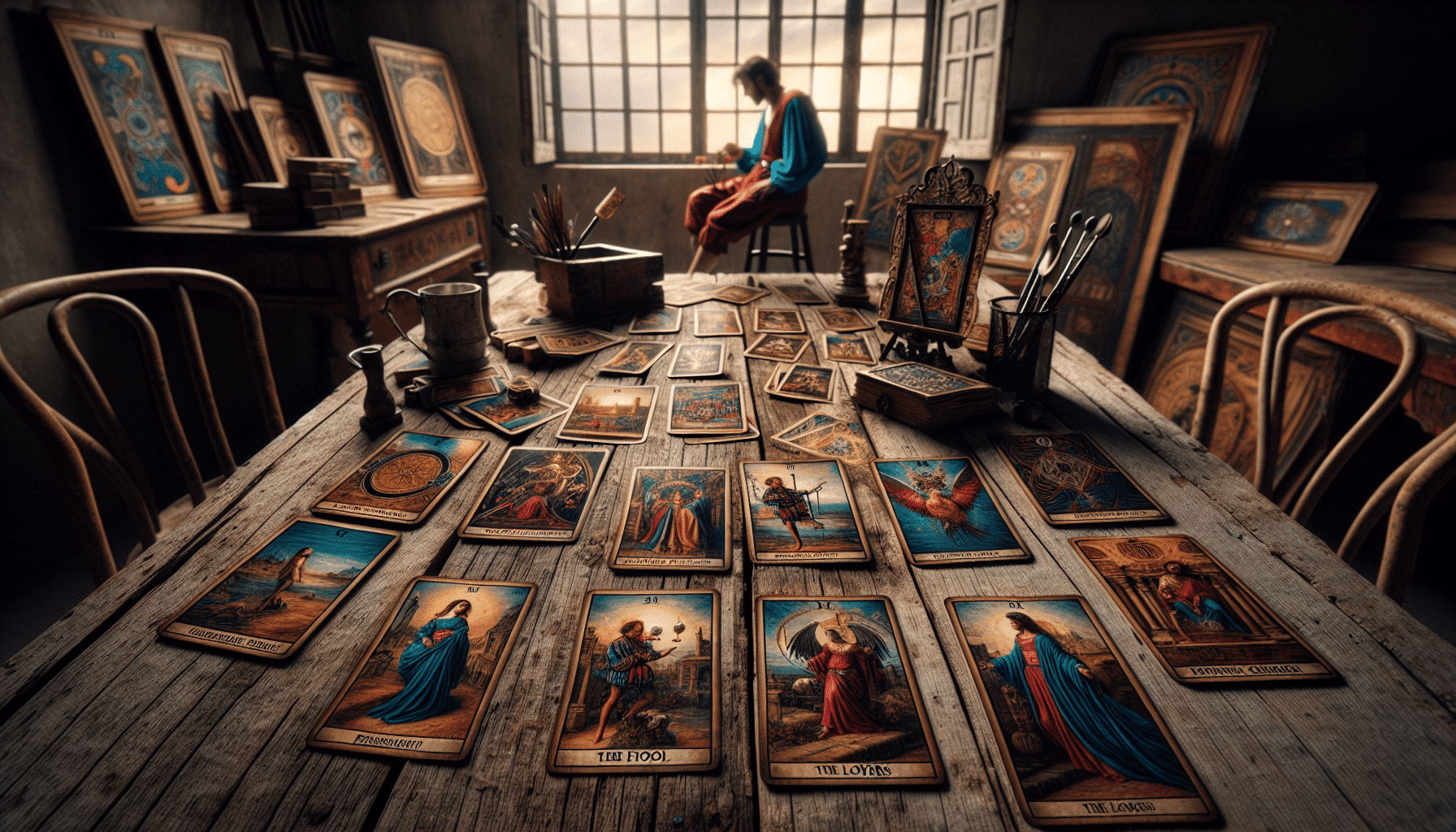
Renaissance artistic and philosophical currents profoundly shaped your understanding of the Tarot’s symbolism and interpretations. As you delve into the cards, you see how Renaissance art, with its emphasis on humanism and individualism, is mirrored in the Tarot imagery. The figures and scenes on the cards reflect the period’s aesthetics and values, capturing the essence of courtly customs and the era’s societal norms.
The characters in the Tarot, like the King, Queen, Knight, and Page, draw directly from the social hierarchy prevalent during the Renaissance. These courtly customs not only determined daily life but also influenced the roles and symbols found within the Tarot. The lavish costumes and intricate symbols you find in many Tarot decks echo the opulent art of the time, replete with allegorical meaning and classical motifs.
The Major Arcana cards, such as The Emperor and The Hierophant, resonate with the authority and religious structures that were central to Renaissance life. Meanwhile, the Minor Arcana cards often reflect the day-to-day experiences of people living in that historical period. Your ability to interpret these cards is enriched by a knowledge of the historical context, lending depth to your readings and a greater appreciation for the Tarot’s enduring legacy.
Learn more with these tarot books here…
Tarot and Medieval Symbolism
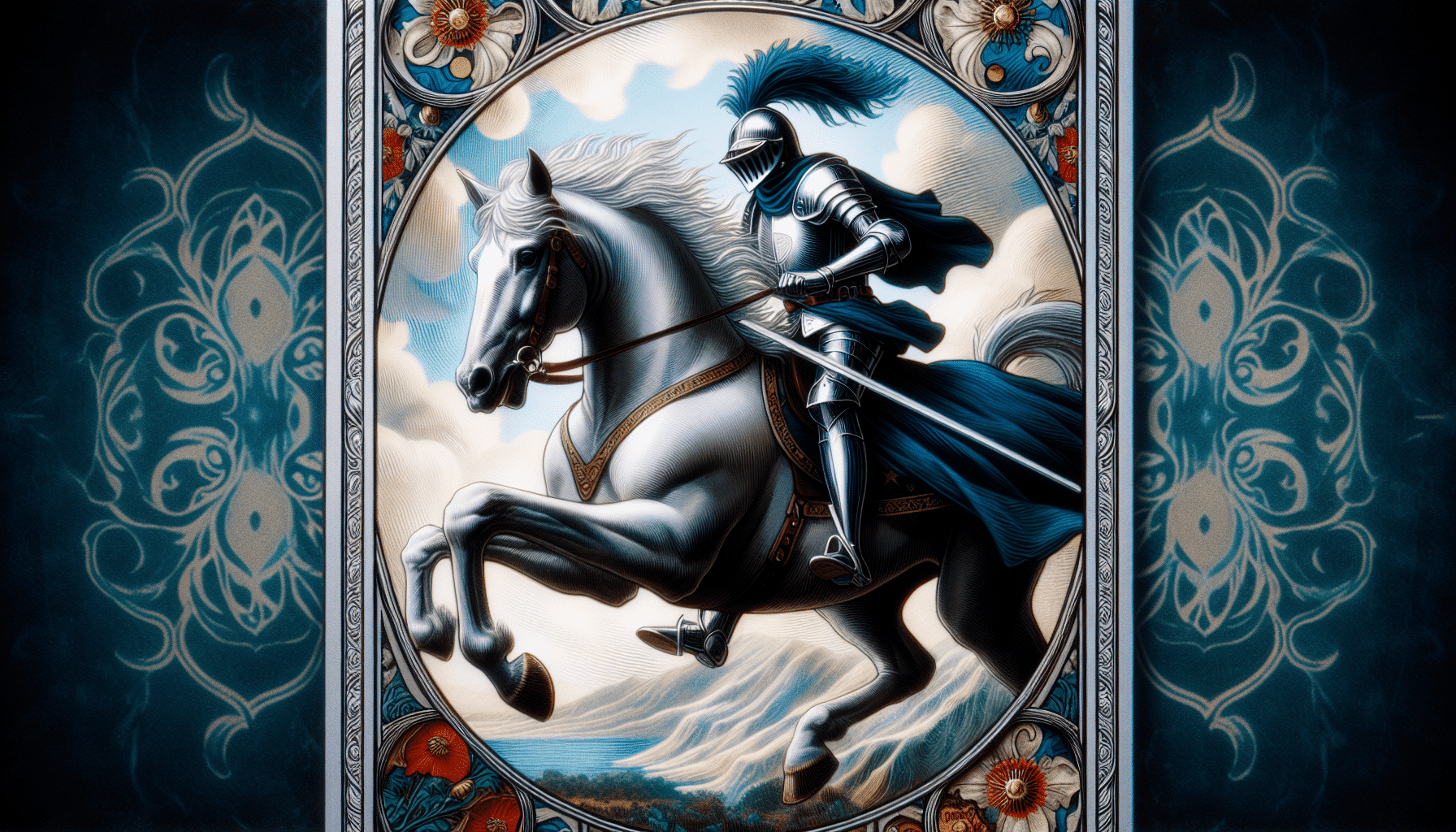
You’ll discover that medieval symbolism infuses the Tarot with its second layer of meaning, beyond the Renaissance influence, revealing a tapestry of archetypal themes and religious concepts prevalent during the Middle Ages. As you delve into the cards, notice how medieval iconography is woven throughout the deck. The figures and scenes aren’t just random; they’re steeped in the era’s spiritual and social motifs.
For instance, the presence of religious and feudal hierarchy is unmistakable. The Tarot’s Kings, Queens, Knights, and Pages reflect courtly practices and the structured order of medieval society. These characters don’t just represent people in your life; they’re emblems of authority, service, and chivalric values that were the backbone of medieval culture.
Moreover, the Major Arcana cards, like The Tower or The Wheel of Fortune, encapsulate the medieval belief in the transient nature of human fortunes, reminiscent of the ‘wheel of fortune’ concept from medieval philosophy. This symbology was a stark reminder of life’s unpredictability and the divine hand in fate.
Learn even more secrets of tarot history here…
Mysticism and the Occult Connection
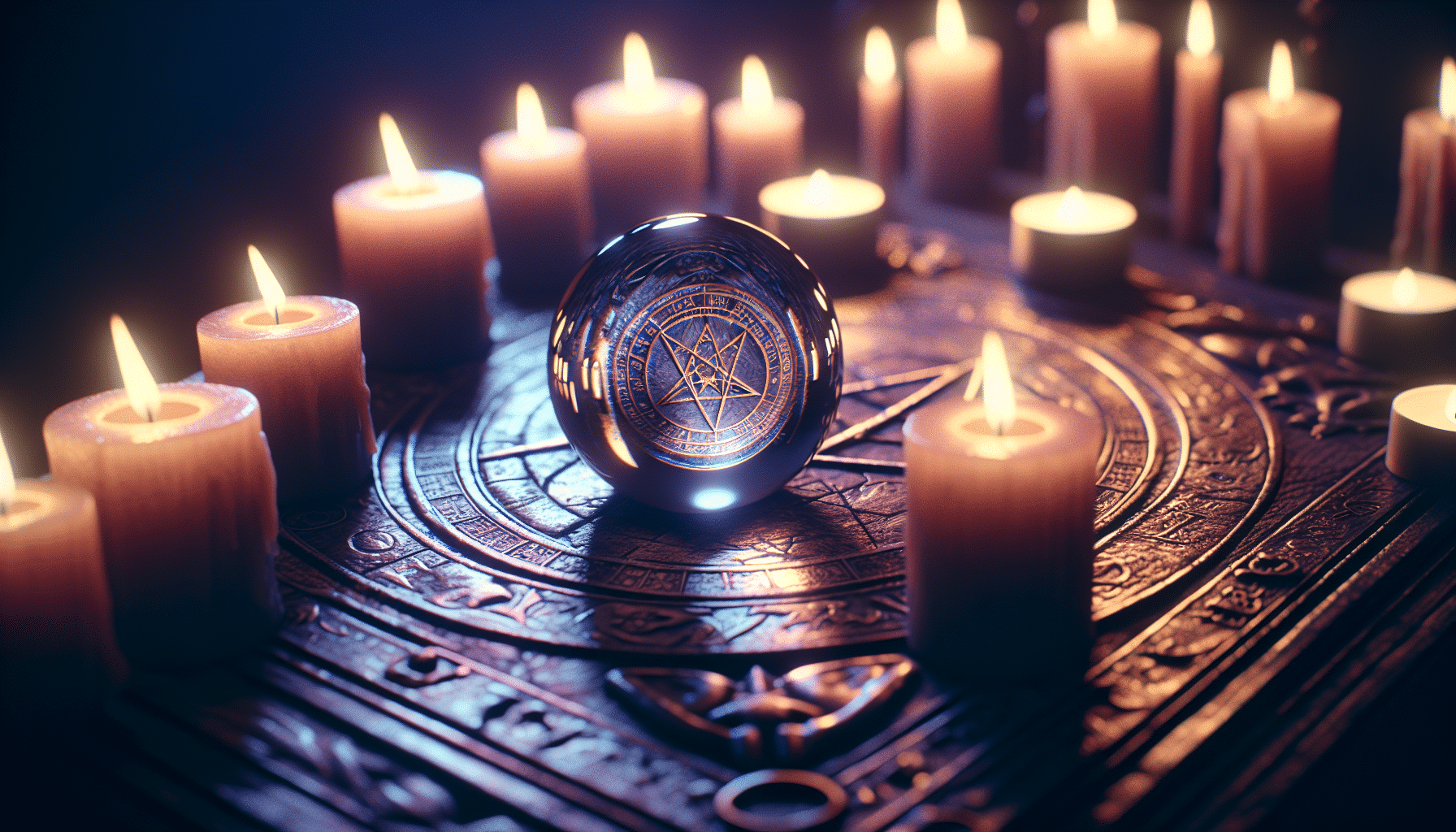
As you explore the Tarot’s enigmatic symbols, you’re peering into the realm of mysticism and the occult, where each card is a key to unlocking esoteric knowledge. These images aren’t just medieval relics; they’re steeped in divinatory practices that have been honed over centuries. The Tarot serves as a bridge between you and the esoteric traditions that have long sought to understand the deeper truths of our existence.
The cards themselves are more than mere pictures; they’re imbued with the collective unconscious and archetypal energies that many believe shape our reality. When you shuffle the deck and lay out a spread, you’re engaging with a form of knowledge that defies conventional wisdom and taps into the mystical.
Historically, the occult connection of Tarot was shrouded in secrecy, accessible only to those initiated into the hidden circles of society. Nowadays, you have the opportunity to connect with these ancient wisdoms openly, allowing you to dive into a world where intuition and insight reign supreme.
As you continue your journey with the Tarot, remember that you’re participating in a living tradition, one that connects you with the mystics and seers of the past, providing guidance for the present.
Tarot in the Age of Enlightenment
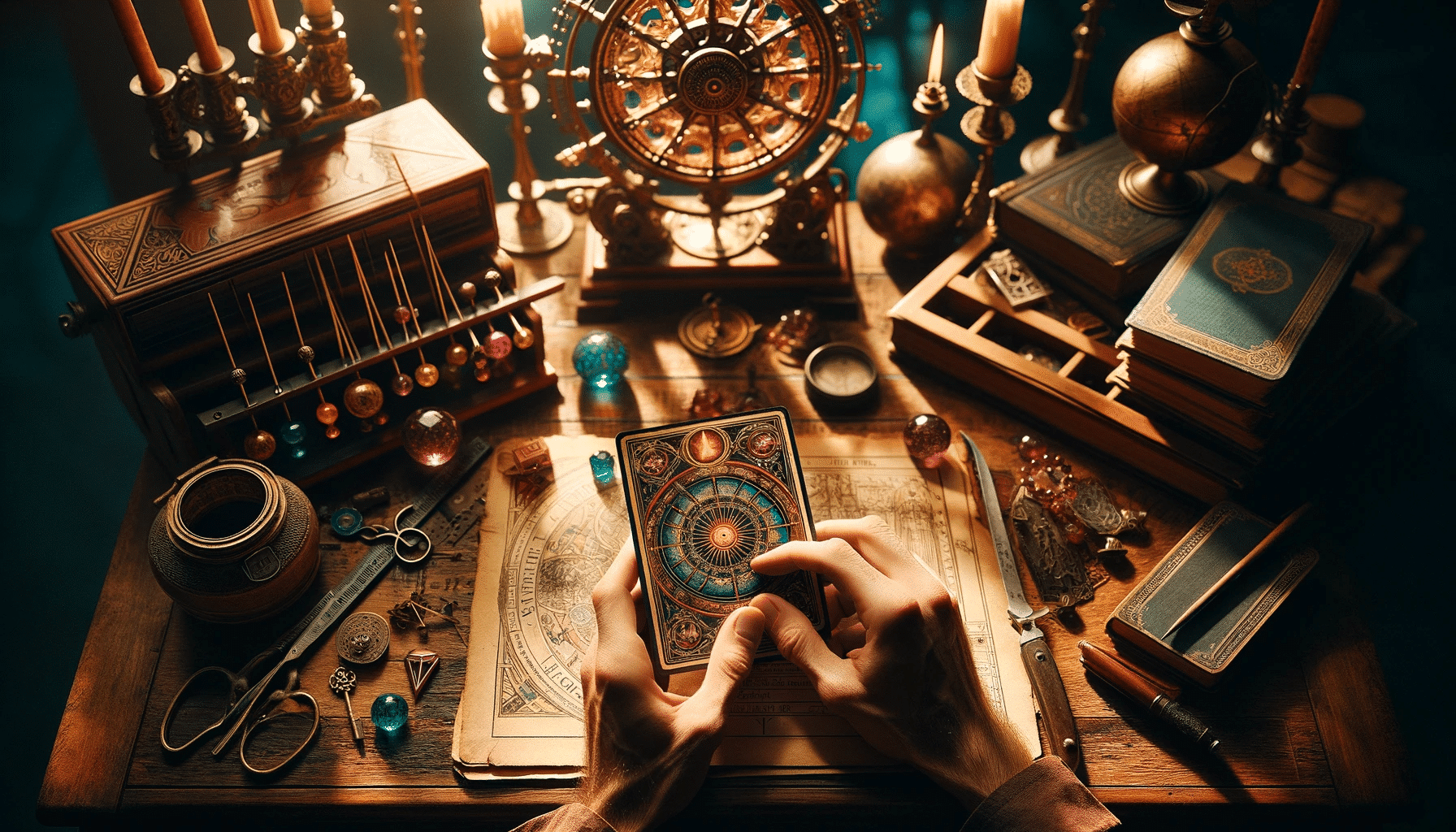
Venture into the Age of Enlightenment, and you’ll discover how Tarot’s interpretations evolved amidst a fervor for reason and empirical knowledge. This period, also known as the Age of Reason, witnessed a shift in how people viewed the world. Enlightenment Tarot readings began to reflect a more analytical approach, considering symbolism and archetypes through the lens of human experience rather than pure mysticism.
The cards were no longer just divinatory tools but were also seen as mirrors to the self, helping individuals understand their own rationality and emotions. Let’s explore some contrasts between pre-Enlightenment and Enlightenment Tarot interpretations in the table below:
| Pre-Enlightenment Tarot | Enlightenment Tarot |
|---|---|
| Mystical divination | Self-reflection |
| Supernatural guidance | Rational analysis |
| Esoteric symbolism | Archetypal insights |
As you see, the transition from mystical to rational interpretation didn’t strip the Tarot of its complexity. Instead, it added a new dimension that aligned with the intellectual currents of the time. The cards became a means to navigate the human psyche, balancing intuitive insights with the enlightened pursuit of knowledge.
Modern Tarot and Cultural Shifts

As you turn the page to contemporary times, you’ll notice how tarot’s meanings have evolved, echoing the dynamism of modern life.
You’ve likely seen tarot’s imagery pop up in films, books, and on social media, showcasing its widespread cultural resonance.
This shift isn’t just aesthetic; it reflects deeper changes in how we seek personal insight and community connection through these age-old cards.
Evolving Symbolic Meanings
You’ll find that the symbolic meanings of Tarot cards have shifted considerably as they’ve been interpreted through the lens of modern cultural changes. Symbolic Fluidity is at the heart of this evolution, reflecting society’s ever-changing values and perspectives.
Today’s divination practices often embrace inclusivity and personal growth, a departure from the more rigid interpretations of the past. The Fool, for instance, once seen merely as a caution against foolishness, now often represents new beginnings and the courage to take leaps of faith. This shift is a direct result of contemporary views on life’s journey and individualism.
Tarot’s Pop Culture Presence
Many modern interpretations of Tarot have permeated popular culture, influencing how you might understand and utilize these mystical cards today. No longer just a tool for divination, Tarot has evolved into various Tarot games and interactive experiences that resonate with contemporary audiences. You’ll see celebrity endorsements shining a spotlight on Tarot’s relevance, further cementing its place in today’s society. These famous faces not only draw attention to the practice but also often share their personal readings, which adds a layer of intrigue and relatability.
The cultural shifts towards spirituality and self-exploration have made Tarot more accessible and acceptable. You’re now more likely to encounter Tarot in mainstream media, art, and even as a theme in popular events, reflecting its widespread appeal and integration into modern life.
Conclusion
You might think tarot’s just a trendy fad, but it’s rooted deep in history. From medieval symbolism to the Age of Enlightenment, tarot’s evolution reflects cultural shifts and human curiosity.
It’s not just about fortune-telling; it’s a mirror of our collective past. So, the next time you see those cards, remember they’re not just playing games – they’re holding centuries of insights, waiting for you to unlock their secrets.
Dive in, and be part of the story.
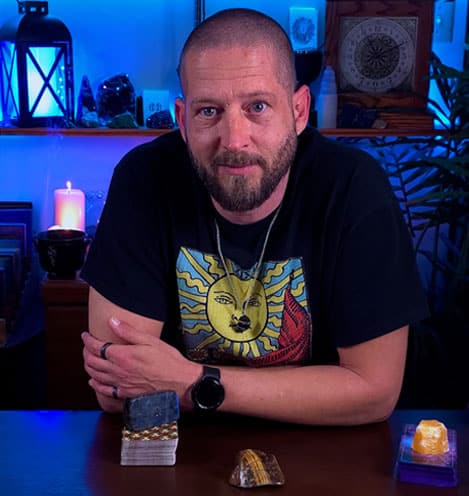
About The Author – Allen Hill
Allen Hill, the force behind Unknown Truth Tarot, has a YouTube following 6-times bigger than the population of his hometown, Miamisburg, Ohio. From his spiritually rich blog on Tarot and crystals to his role as CEO of The Unknown Truth Tarot Metaphysical Shop, Allen’s passion for the metaphysical shines through.
A master Tarot reader and “crystal junkie,” Allen is also a devoted dad to Dylan, 10, and Destiny, 24. When he’s not immersed in the world of Tarot and crystals, he enjoys poker and video gaming sessions, often humorously outplayed by Dylan.
Follow Allen on Twitter, Instagram, Facebook, TikTok, and subscribe to his Unknown Truth Tarot YouTube channel to join him on a journey of spiritual growth and self-discovery.

